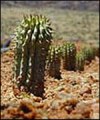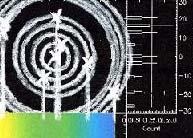 This southern African succulent plant tastes nasty but generations of San bushmen in the Kalahari Desert have eaten it to suppress their appetites on countless hunting trips. As such, it has become a focus of quick-fix weight loss programs.
This southern African succulent plant tastes nasty but generations of San bushmen in the Kalahari Desert have eaten it to suppress their appetites on countless hunting trips. As such, it has become a focus of quick-fix weight loss programs.
What is Hoodia gordonii?
It’s a prickly succulent plant that grows in southern Africa and resembles a cactus but isn’t one.
What can it do?
Hoodia gordonii can apparently reduce calorie intake and lower body fat. A patented extract known as p57 and owned by Phytopharm is currently undergoing clinical safety and efficacy tests.
Why do the San bushmen use it?
They eat it for food, althouh H gordonii itself is bitter tasting and only eaten when the going gets really tough.
How was Hoodia’s appetite suppressing properties discovered?
It was investigated as part of a scientific research project established by the South African Council for Scientific and Industrial Research, which tested lots of bush foods and discovered that surprisingly Hoodia extracts made you feel fuller than you really were as well as lowering body weight without toxicity.
Do all Hoodia species reduce appetite?
Only Hoodia gordonii extract has been tested clinically on human volunteers, but that doesn’t necessarily mean that whole plant extract or other products won’t work.
So it definitely works?
Phytopharm’s 2001 double-blind, placebo-controlled clinical trial of overweight, but healthy volunteers showed a statistically significant fall in daily calorie intake as well as a drop in body fat percentage. [There is anecdotal evidence that products obtained from the plant (rather than isolated extract) can reduce body weigth]
Does it work quickly?
Large doses are needed but it takes just 15 days to see a calorie reduction on average of 1000 (kcal) per day.
What are the side-effects?
None have been found so far, but that does not mean that safety studies are not needed before it can get the green light for safety and efficacy.
Will the San bushmen benefit from the sales of Hoodia?
CSIR has entered a “benefit-sharing agreement” with a San representative organisation to ensure they benefit financially from the commercialisation of patented Hoodia gordonii extract. (Actually CSIR did not, allegedly, enter this agreement voluntarily but did so as a result of legal action).
Hoodia is CITES listed, what does that mean?
It means if you visit southern Africa and steal the succulent plant and try and take it out of the country or otherwise gain from it, you’ll get fined massively and face a jail sentence under the Convention on International Trade in Endangered Species of Wild Fauna and Flora.
The BBC reported on the Phytopharm trials in May 2003 and was saying then that potential users should be patient. In their report, they pointed out that the Hoodia tablets available via the internet that they had tested did not contain any of the active ingredient. A natural pill for obesity that really works will come, it just may be another few years in the making.
The original Phytopharm FAQ can be found here. More information on the various Hoodia species is available here.
Phytopharm has, I have been told, sold their licence to Unilever.

 Also, in partnership, Sciencebase is offering a free trial issue of Photovoltaics International to qualified subscribers – senior engineers and executives working in companies that produce wafers, cells, modules, install utility grade installations or are at current utility grade energy companies working with solar as a power generation source.
Also, in partnership, Sciencebase is offering a free trial issue of Photovoltaics International to qualified subscribers – senior engineers and executives working in companies that produce wafers, cells, modules, install utility grade installations or are at current utility grade energy companies working with solar as a power generation source. After centuries of speculation concerning the existence or otherwise of extraterrestrial intelligence, it has been discovered that a radio signal detected by the Arecibo Observatory in Puerto Rico contains artwork broadcast from deep space.
After centuries of speculation concerning the existence or otherwise of extraterrestrial intelligence, it has been discovered that a radio signal detected by the Arecibo Observatory in Puerto Rico contains artwork broadcast from deep space.  It might seem like a trivial question, and most people would probably say 28 days. But, it isn’t so simple.
It might seem like a trivial question, and most people would probably say 28 days. But, it isn’t so simple. This southern African succulent plant tastes nasty but generations of San bushmen in the Kalahari Desert have eaten it to suppress their appetites on countless hunting trips. As such, it has become a focus of quick-fix weight loss programs.
This southern African succulent plant tastes nasty but generations of San bushmen in the Kalahari Desert have eaten it to suppress their appetites on countless hunting trips. As such, it has become a focus of quick-fix weight loss programs.